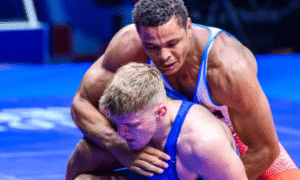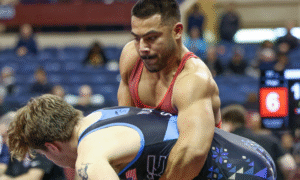It seems that the 59 kilogram weight class in the US just got put on blast.
Hayden Tuma (Army/WCAP) made his 59 kg debut Saturday at the 2016 Bill Farrell Memorial Open in New York City and whatever attributes he had at 66 carried over and then some at the lower weight. In all four of his matches, Tuma kickstarted a merciless gameplan which appeared grounded towards breaking each opponent. There was rarely any time to breathe. The only juncture where his output appeared to flutter a little came in his first bout of the day against another soon-to-be stud, Northern’s Andrew Ibarra. Tuma raced out to an early 4-0 lead when he cinched an air-tight front headlock and turned it over. Ibarra stayed in it as much as he could manage, but had trouble keeping up. Tuma took the bout 5-0.
Against Dmitriy Ryabchinsky (NYAC-OTS), it was a wicked headlock in the first period that got him going. Ryabchinsky nailed a two-point arm throw in retaliation to cut the score in half. A passivity penalty point and a cover off of a Ryabchinsky headlock attempt sealed it in his favor 7-2. The semifinals saw him take on Sammy Jones (NYAC-OTS). Tuma nursed a 1-0 lead going into the second period before hitting another headlock near the edge for four. Jones reversed, making the score 5-1. This was an important bout for Jones, as well. Jones is in the mix like never before at 59 and this event had the potential to get that point across. The problem? Tuma was completely on his game and came out on top 6-3.
The finals pitted Tuma with Shota Tanokura (JPN). And again, the WCAP wrestler drew first blood, this time with a bodylock that yielded two points. Tanokura answered back with a clean front headlock he spun around on to bring the match to 2-2. In the second, Tuma was the beneficiary of a passive point to take the lead. But it was tenuous. Tanokura clamped on a two-on-one and pushed forward with it, clearing Tuma’s balance, causing him to scramble to the mat. Tanokura followed right behind to get the takedown points. The final score, 4-3 in favor of the Japanese wrestler.
Although he didn’t emerge with a gold medal, Tuma demonstrated that he can be a real contender at 59 going forward. There were no discernible ill-effects from the drop in weight (although, he did have a two kg allowance). Rather, he exhibited a heightened-sense of alertness in each exchange and went about his work with renewed confidence. But make no mistake about it — there are killers at this weight in the US. Jesse Thielke (NYAC), the reigning Olympian, will be back in action by the time the spring heats up and Ryan Mango (Army/WCAP) and Ildar Hafizov (Army/WCAP) are widely recognized as the biggest threats besides Thielke. Still, if Tuma can put together a string of performances like this one, there isn’t any doubt his stock will continue to rise.
Bey turns it up for his first Senior gold; Hancock, too
Kamal Bey (75 kg, Sunkist) just can’t help it. Whether it’s the way his body and brain work together or if there is some mystical element that gets involved every time he wrestles, the guy just cannot be part of a boring match. At least not if he has any say about the situation. In what was a light bracket, Bey started the day by taking apart Bradley Dolezal (Minnesota Storm) 8-2. Dolezal wasn’t totally out of this one the until late in the second period. With the score at 4-2, Bey dug in high double underhooks and hipped it over for four to bring his lead to 8-2. He then held the position and got the fall to move to the final.
In the 75 kg final at the 2016 Bill Farrell Memorial Open, standing across from Bey was Egyptian-born Karim Hawash (NYAC), a technically-sound and experienced Greco Roman competitor who himself had enjoyed a dominant afternoon leading up. Hawash defeated both Broc Clark (Marines) and 2016 University National champ Jesse Porter (NYAC-OTS) via tech and apparently didn’t feel the need to waste any time in the final, because right after the whistle he tossed Bey with a headlock for a clean four points. The message was received.
Bey would tap into his scrambling ability to carry him back in this. He got behind on Hawash for two off of another attempt by the NYAC wrestler, but that is when the chaos started. Bey hit a slide-by off the edge but Hawash reversed; Hawash then locked a gutwrench only to have Bey step over to expose his back. 6-5, Bey. Soon after, Bey lassoed double overhooks and brought the hold over for four. 10-5, Bey. He was now fully engaged. The NYAC corner offered a challenge for the four-point sequence but Hawash declined.
With only mere seconds remaining in the period, Hawash lowered in for a high dive. Bey instantly countered by weaving in a right underhook, muscling it right over at the edge for four at the whistle. This time, the NYAC challenge was accepted by their wrestler though it wouldn’t make a difference. Bey walks away with an impressive 15-5 technical fall and his first Senior gold. And like they say, you never forget your first.
For 2016 Junior World medalist G’Angelo Hancock (98 kg, NYAC), the 2016 Bill Farrell Memorial Open also resulted in a first-time domestic Senior gold. It has been an extremely busy year for the 19-year old. Hancock made the US National Team in April by virtue of finishing third at the 2016 Olympic Trials. He then went on to make both the Junior and University World teams later in the spring; won out at the Junior Greco World Duals; trained throughout the summer with the Olympic team; earned said bronze medal at the Worlds a couple of months ago; and took a gold and a silver at two consecutive tournaments in Sweden just this month.
So it would have been understandable if he didn’t completely have his fastball after arriving back in the US from Sweden earlier last week. But that didn’t turn out to be the case here. Hancock was tested in the quarterfinals by Masato Sumi (JPN) but still managed to pitch a 5-0 shutout on the strength of a takedown bookended by a two passivity points (a lost challenge by Japan was responsible for another point). Next, he blew the doors off of Zach Merrill (Titan Mercury) with back-to-back reverse lifts to put him into the final against 85 kg US National Team member Hayden Zillmer (Minnesota Storm).
Zillmer himself is a very skilled, very solid all-around competitor who looked sharp at the higher weight class, though he had to grind it out to make it to the final. Understandable considering the circumstances. In their showdown, which was a contentious affair despite the lack of points, Zillmer was able to frustrate many of Hancock’s tie-up attempts and turn off of angles few opponents usually consider when going up against the young phenom. Hancock remained active nonetheless. He was holding onto a 1-0 lead in the second period and had Zillmer backing up, netting him another point. It wasn’t the prettiest of matches. Few bouts decided by passivity are. But it was a solid win for Hancock over a fellow young National Team member not to mention, a nice way to keep the train moving in the right direction.
Morrow making his case at 66
Austin Morrow (66 kg, NYAC-OTS) might not have won the 2016 Bill Farrell Memorial Open, but what he did win was respect. Morrow wrestled nearly lights-out last weekend at the Malarcupen and he picked up right where he left off in New York City. The 23-year old was forced to dig in and fight it out with Raymond Bunker (Marines) in his first bout of the day, a 5-0 win. It was the semifinals when Morrow really came to life. After giving up a takedown to Karim Ibrahim-Abouvayya (NYAC), Morrow turned on the meanness. He constantly had Ibrahim-Abouvayya on his heels, moving him around the mat trying to get to the body. A takedown, a lift, some step-outs…once Morrow assumed control of this match, it was as good as over.
The gold medal bout saw Morrow paired with Ktsuyoshi Kawase (JPN). This one would not go as planned for the American. Morrow started off dictating where the action took place and earned a passive point in the process. Kawase, however, was waiting for the slightest chance to waterfall a headlock and he found one a little past midway through the first. Morrow had just been in on an attempt when Kawase isolated his head and arm. The Japanese wrestler in a flash got underneath and torqued his hip for a no-doubt-about-it five points. Morrow couldn’t escape the position and was soon called for a fall at 1:53 of the first period.
With the silver medal, Morrow might not have gotten the result he wanted, but he certainly showed that he is becoming a major player at 66 kilos in the US. It has been a steady climb for the Washington native and it bears mentioning the progress he has made over the last two years. Morrow has accumulated important experience that he is being able to translate in competition. He is also slated to wrestle next month at the Nationals in Las Vegas and assuming he makes that trip, Morrow will be in the running for a title.


















